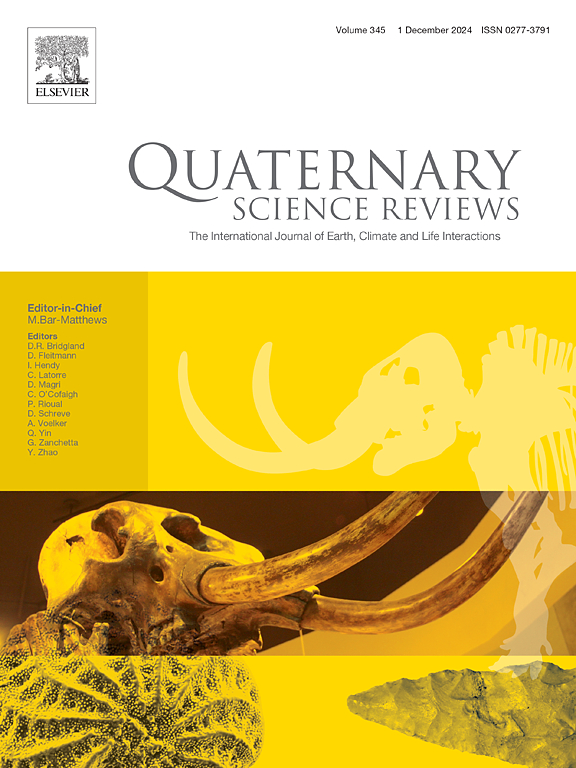Examining the relationship between temperature and δ18O of freshwater molluscan carbonate from modern and Pleistocene fluvial sediments from the British Isles
IF 3.2
1区 地球科学
Q1 GEOGRAPHY, PHYSICAL
引用次数: 0
Abstract
The δ18O of freshwater molluscan carbonate (δ18Oc) from fluvial sequences has the potential to be a key palaeoclimate archive, given the close association between δ18Oc values and temperature in temperate lowland freshwater systems. However, the scarcity of systematic modern and Pleistocene studies from these deposits has limited the use of molluscan carbonate δ18Oc as a proxy for climate change. Here we present a study of fluvial molluscan carbonate δ18Oc from modern river systems and Pleistocene fluvial sequences located in central and southeast Britain. We compare molluscan carbonate δ18Oc from four species of gastropod to independently-derived estimates of temperature from the same contexts. We demonstrate that the δ18Oc of modern shells from three sites in southeast Britain are consistent with formation under equilibrium conditions with modern water temperature and δ18Ow values, which are in turn controlled by prevailing air temperature. The relationship between the δ18Oc value and temperature is also observable in the data obtained from fossil shells from ten Pleistocene sequences. Despite uncertainties with the interpretation of both the δ18Oc and palaeotemperature data at several localities, and the paucity of mollusc shells from cold climate contexts, this study highlights the potential of using δ18Oc analysis to obtain palaeoclimatic records from long Pleistocene fluvial sequences in temperate regions.
研究了不列颠群岛现代和更新世河流沉积物中淡水软体动物碳酸盐岩的温度与δ18O的关系
鉴于温带低地淡水系统δ18Oc值与温度之间的密切联系,河流层序中淡水软体动物碳酸盐岩的δ18O值(δ18Oc)有可能成为一个关键的古气候档案。然而,由于缺乏对这些沉积物的系统的现代和更新世研究,限制了用软体动物碳酸盐岩δ18Oc作为气候变化的代表。本文对位于英国中部和东南部的现代河流水系和更新世河流层序中的河流软体动物碳酸盐岩δ18Oc进行了研究。我们比较了来自四种腹足动物的软体动物碳酸盐岩δ18Oc与来自相同环境的独立导出的温度估计。研究结果表明,英国东南部3个地点的现代壳的δ18Oc值与现代水温和δ18Oc值的平衡条件下形成相一致,而现代水温和δ18Oc值又受盛行气温的控制。在10个更新世层序的化石壳资料中也可以观察到δ18Oc值与温度的关系。尽管在一些地区δ18Oc和古温度数据的解释存在不确定性,并且在寒冷气候背景下软体动物壳的缺乏,但本研究强调了使用δ18Oc分析获得温带地区长更新世河流序列古气候记录的潜力。
本文章由计算机程序翻译,如有差异,请以英文原文为准。
求助全文
约1分钟内获得全文
求助全文
来源期刊

Quaternary Science Reviews
地学-地球科学综合
CiteScore
7.50
自引率
15.00%
发文量
388
审稿时长
3 months
期刊介绍:
Quaternary Science Reviews caters for all aspects of Quaternary science, and includes, for example, geology, geomorphology, geography, archaeology, soil science, palaeobotany, palaeontology, palaeoclimatology and the full range of applicable dating methods. The dividing line between what constitutes the review paper and one which contains new original data is not easy to establish, so QSR also publishes papers with new data especially if these perform a review function. All the Quaternary sciences are changing rapidly and subject to re-evaluation as the pace of discovery quickens; thus the diverse but comprehensive role of Quaternary Science Reviews keeps readers abreast of the wider issues relating to new developments in the field.
 求助内容:
求助内容: 应助结果提醒方式:
应助结果提醒方式:


